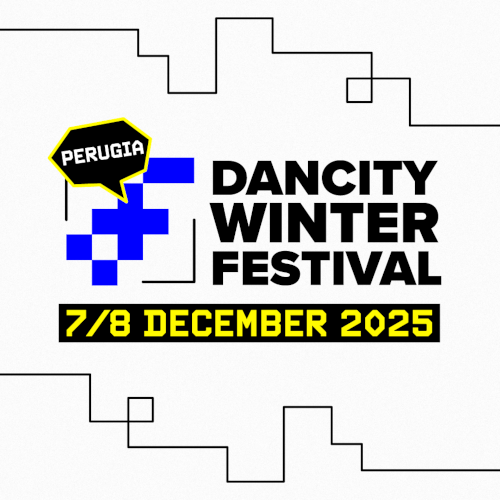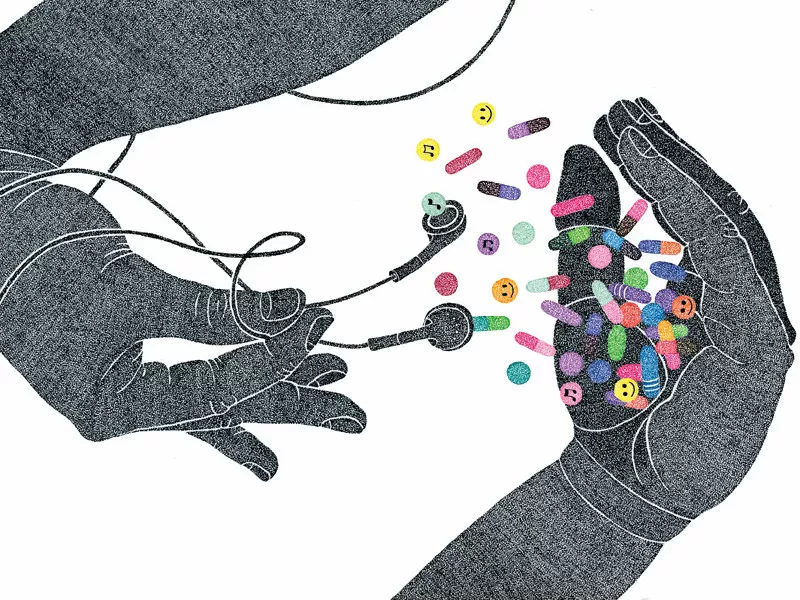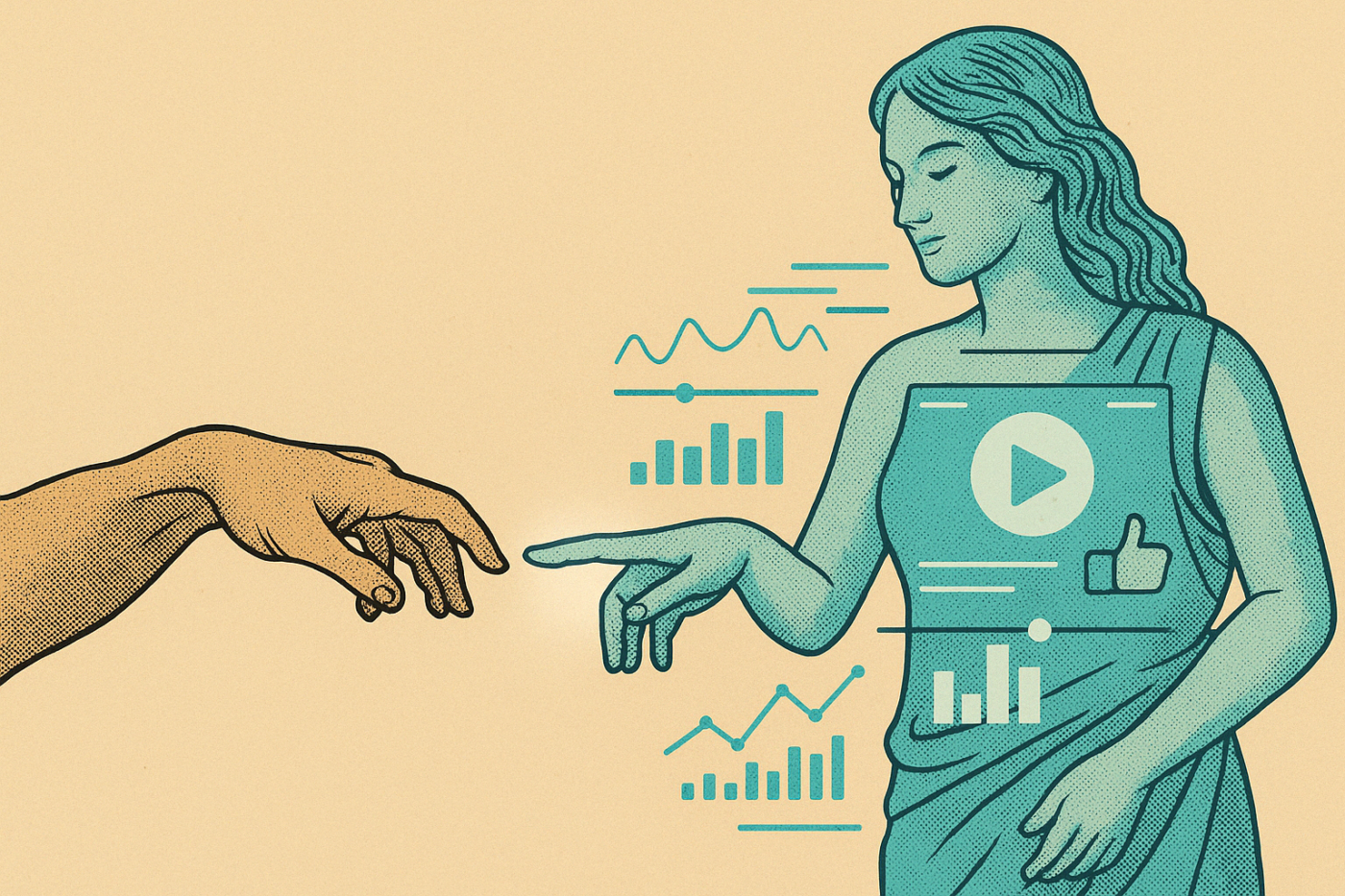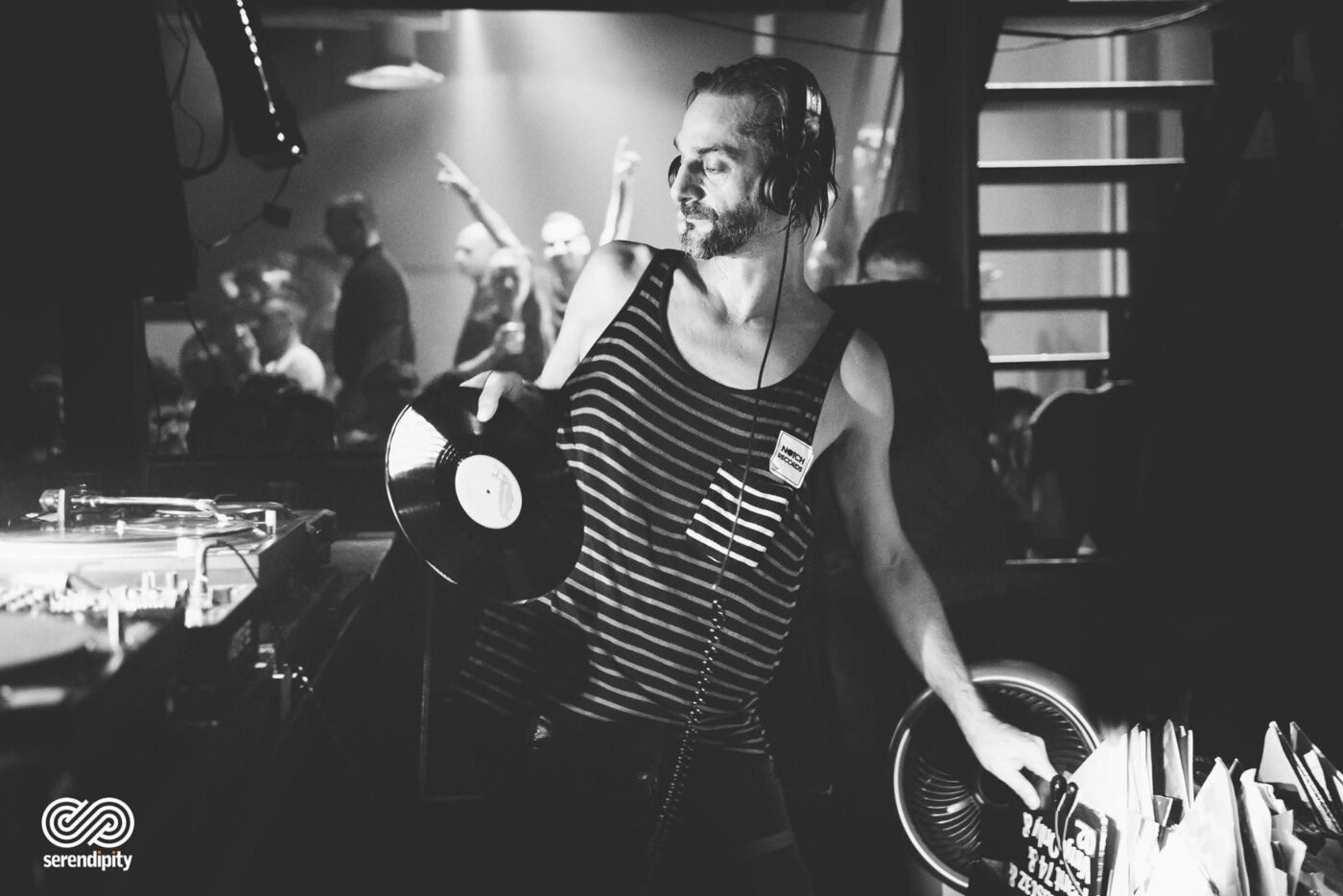A journey through intoxication and control
Part 1 — Rites, Rhythm, and Vision
A headline has made the rounds on social media: “Deaths linked to ketamine have increased by 2000% since 2014.” It’s a striking figure, but one to be understood before being feared: the percentage rise starts from very low values — more a cultural signal than a public‑health emergency. Yet a question remains: how did an anaesthetic designed to put bodies to sleep in operating rooms become the emblem of a generation trying to stay awake?
Every era has its drug — not so much for fashion or chemistry, but to serve a need for meaning. Humans never stopped seeking an elsewhere: a passage, an ecstasy, a crack in reality through which to glimpse mystery. But the direction of that escape always reveals its time: ascent or descent?
Long before music was entertainment, it was a spiritual technology. In ancient cultures, sound and substance coexisted as tools to cross the threshold of the ordinary. In the Eleusinian Mysteries, the barley-and-rye brew — the kykeon — probably contained a psychedelic alkaloid, perhaps derived from ergot. But the point wasn’t the substance; it was the frame. Processions, silences, preparation. You drank in a state of dedication, immersed in chant and night. In the Amazon, ayahuasca was taken after fasting, prayer and sexual abstinence. It wasn’t a party; it was pedagogy. The hallucination wasn’t meant to get wasted, but to see with other eyes. Body, sound and breath formed a single gnoseological device. It wasn’t consumption: it was consecration.
Today, when an electronic beat rumbles in a dark space, something of that ancestral memory awakens. But the frame is missing: rite, silence, preparation. Without context, the experience dulls instead of opening. We’ve multiplied “freedom moments” until they’ve become compulsory. Every weekend the same formula: lights, subs, substances. A rite repeated without intention loses power: it becomes an automatic gesture — anaesthesia of the present. Where the ancients met transcendence in rare ceremonies, we reproduce it in series. And so, instead of expanding consciousness, we saturate it.
Ketamine — the dissociative par excellence — perfectly mirrors this condition: it doesn’t make us travel, it detaches us. It lets us be elsewhere while staying here. The body vibrates but does not feel.
All ancient rites knew the power of rhythm. The steady drumbeat syncs heart and breath: a natural hypnosis. Ethnomusicologist Gilbert Rouget argued that trance arises from the social relationship between sound and group: collective chant, circular dance, shared breathing. In the electronic realm that rhythm returns in other forms — techno, ambient, trance, downtempo — musics that modulate consciousness, often without symbolic context. The dancefloor sometimes brushes the sacred; more often, the rite has been stripped of meaning. The drum remains; the vision is gone.
In archaic societies, drunkenness wasn’t judged, it was disciplined. Shamans drank in service of the group. Dionysus wasn’t the god of chaos but of the higher order that only ecstasy can reveal. Today, with neither mythology nor rite, we attempt the same experience with new tools but no frame: chemistry replaces symbol, sound replaces song, the crowd replaces community. The result is more apparent freedom and less real meaning. The rite is no longer a shared journey but an individual drift among others.
Every substance is neutral in itself: intention turns it into a tool or a trap. Perhaps the mistake isn’t the search, but searching without language. A thread links the African drum to a Funktion‑One stack: physical vibration. In deep sound, the body regains its place. But to experience it, we must relearn how to feel. The problem is neither music nor substance: it’s how we dwell within them. Maybe we should treat the dancefloor again as a place of total sensory experience, not a factory of numbness. Give the body the right to perceive, not only to endure. Perhaps then, even without substances, we could truly step outside ourselves again.
Soundtrack of the Ancients
- Hildegard von Bingen – O Eucari in Leta Via
- Piero Umiliani — Synthi Time
- Jon Hassell — Last Night the Moon Came
- Voices from the Lake — Inside the Outside
- Ryuichi Sakamoto & Alva Noto — By This River (live)
- Brian Eno — An Ending (Ascent)
Part 2 — The Century of Synthetic Sound
In the twentieth century the urge to alter takes new forms: musical genres become social experiments, and sound intertwines with chemistry in a dialogue between body, culture and technology. Each era finds its exit route in a different mix of notes and molecules. Jazz, rock, disco, techno — four languages telling the same restlessness.
Jazz — the body’s truce. In Harlem’s smoky rooms, heroin accompanies melancholy. For Charlie Parker or Billie Holiday it wasn’t euphoria but respite. In jazz, opiates don’t fuel escapism; they enable an aesthetic survival.
LSD — the promise of the universe. In the Sixties, counterculture invokes mind expansion: turn on, tune in, drop out. Psychedelic rock believes, for a moment, it can fling reality open — and for a moment it does. Then the vision splinters: expansion becomes labyrinth.
The Seventies — the rush and the crash. Cocaine replaces heroin: no more melancholy, but efficiency. Disco builds temples of light; punk digs basements of rage. Both live as if tomorrow were a printing error.
House, rave, MDMA — the utopia of “we”. In Chicago and Detroit, machines learn to play the soul. MDMA becomes the chemical code of union — a civic spirituality forged from industrial ruins. For an instant the boundary between individual and group dissolves.
History doesn’t proceed by substitution but accumulation. Each generation inherits and mixes substances as it does musical genres. In the rave scene, ecstasy lights up communion, ketamine slows the pulse, acid reopens doors — all in the same flow, the same night. It’s a chemical mosaic reflecting a complex social body: euphoria and suspension, contact and flight, drive and surrender — all together on the same dancefloor.
The new millennium — fatigue and oblivion. Ketamine enters clubs as an anaesthetic masquerading as experience: the drug of a generation that prefers to float rather than fight. In the music of Burial, Actress or Kode9, energy no longer explodes: it vibrates, retreats, dissolves. Dissociation is not only pharmacological; it is cultural.
Soundtrack of the Fall
- Billie Holiday — Don’t Explain
- The Velvet Underground — Heroin
- Jefferson Airplane — White Rabbit
- The Beatles — Tomorrow Never Knows
- The Prodigy — Voodoo People
- Underworld — Born Slippy
- Kode9 feat. Warrior Queen — Sine of the Dub
- Burial — Archangel
- Actress — Hubble
Part 3 — To Punish or to Understand
For decades, drug policies have treated substances as an external enemy, without asking about the context that feeds the need. Yet the impulse to alter perception arises within the very culture that condemns it. Some seek to expand the mind — an almost bourgeois privilege — while others simply try to survive. When inequalities grow, substances change function: they become social anaesthetics, tools to make the unchangeable bearable. At the top one seeks meaning; at the bottom, relief. In both cases, the void is the same.
To punish use is to punish the human desire to feel more. The American “War on Drugs” jailed millions without reducing consumption, whereas Portugal’s decriminalisation and social services saved lives. Where dependence is treated as a health issue, not a policing one, society heals. Every overdose prevented is worth more than a thousand slogans.
In Italy, the 1990 law still frames policy. Public services (SerD) operate with reduced staff, and harm reduction is in the Essential Levels of Care but rarely funded. The result is a system that punishes more than it understands. Punishment is convenient: cheaper than understanding. But punishment divides, creating “us” and “them”. Every society decides whose desire gets pardoned: wine is culture; cannabis is deviance.
During the 2008 crisis, more than three hundred billion dollars from the drug trade entered the global financial circuits to keep banks afloat. Antonio Maria Costa, head of the UNODC, stated that “in many cases, drug money was the only liquid investment capital available.” The very institutions that fund awareness campaigns today were then propped up by their proceeds. Dependence is not only of bodies but of capital itself.
Today finance no longer needs narco-dollars to survive; it has internalised their logic. It functions like the drug market: create dependence, raise the threshold, multiply the need. Now the substance is no longer powder: it is consumption, speed, distraction.
The street dealer rarely ends up in prison — not because the system is humane, but because it is inefficient. The last link is often a kid with more debts than drugs, while the top wear suits. “Punish” has become a political slogan, a language of consensus. We hit what is visible, not what is decisive.
From cocaine in Gioia Tauro’s containers to HSBC accounts laundering Sinaloa cartel dollars, up to Captagon funding militias in Syria, only the geography of power changes. Money follows the same rule as always: it doesn’t stop at the law — it circumvents it. When a scandal breaks, the profits have already been reinvested. This is not about chemistry but structure. The substance changes its name; the chain remains.
Every Saturday night, seventy or eighty euros change hands to buy a temporary escape. Within that money there is, almost always, an involuntary contribution to some of the planet’s worst crime. A tiny gesture that, multiplied by millions, becomes a parallel finance. Those who seek freedom end up — unknowingly — feeding their own prison.
This is not moralism but awareness. Each time consciousness switches off, someone else decides where the money goes, who gets to live and who doesn’t. Money has no ideology: it moves from the hands of those who suffer to those who bomb. Alteration, born as an individual flight, ends up sustaining the very system that keeps us still.
It isn’t an indictment but an appeal: to remember that the only truly psychedelic trip today is toward collective awareness. And that music, once again, can open a breach — not to escape, but to stay lucid together.
Soundtrack of Care
- Prince — Sign o’ the Times
- Massive Attack — Teardrop
- Piero Umiliani — Tempo Sospeso
- Kode9 — 9 Samurai
- Jeff Mills — The Bells
- Jon Hopkins — Open Eye Signal
- Ryuichi Sakamoto — Andata (Solo Piano)
Main Sources
- Office for National Statistics (UK), Drug poisoning deaths, 2022.
- Wasson, Hofmann, Ruck, The Road to Eleusis, 1978.
- Gilbert Rouget, La musique et la transe, 1980.
- Johann Hari, Chasing the Scream, 2015.
- Timothy Leary, Flashbacks, 1983.
- Simon Reynolds, Energy Flash, 1998.
- Mark Fisher, Ghosts of My Life, 2014.
- UNODC (2009), “The Global Drug Trade and the Financial Crisis”.
- EMCDDA, Portugal: Drug Policy Profile, 2021.
- Italian Government, Annual Report to Parliament on Drug Addiction (2023).
- US Senate Report on HSBC and Sinaloa Cartel (2012).
- BBC / The Guardian (2023), investigations on Captagon and Syrian trafficking.

Dancity Mag was created by the cultural association Dancity, which has long been dedicated to promoting contemporary music and culture. The association warmly invites everyone to join the upcoming winter edition of the Festival, taking place on December 7–8, 2025, in Perugia. Tickets available on DICE.
Hai un ricordo del Dancity?
Racconta la tua esperienza, carica foto e aiutaci a tenere viva la memoria collettiva!
Our project is independent and non-profit.
If you enjoy what we do, you can support us with a small donation.
This article was produced with the support of AI tools, used for content organization and textual optimization. The sources, ideas and materials come from the archive and activity of the Dancity Association.





